In the list of 182 line-item vetoes released last Friday by Gov. Mike Dunleavy, one didn’t make his press office’s“items of interest” tally. Buried in the more than $400 million in cuts, Dunleavy defunded the entire $2.8 million of the Alaska State Council on the Arts budget — effectively eliminating the state arts agency.
Of that veto, Dunleavy slashed $1.1 million in an item called “statutory designated program receipts,” money that comes from non-state sources. Of the $2.8 million cut, $700,000 is state money, said Council Chairman Benjamin Brown of Juneau.
“Counterintuitive doesn’t begin to discern how hard it is or impossible for me to understand the logic behind these purported vetoes,” Brown said.
“It’s so unreasonable,” said Asia Freeman, artistic director of the Bunnell Street Arts Center, one of the Homer arts groups that receives ASCA grants. “It’s such an ineffective way to think of cutting.”
If the Alaska Legislature, meeting jointly as the House and Senate, does not get the 45 out of 60 votes to override Dunleavy’s veto, that will mean a $30,000 to $35,000 hit to Bunnell Street Arts Center, Freeman said.
“It’s fairly significant for us,” she said. “It’s comparable to one of the jobs here. It’s comparable to an entire program. A really good example of that is the Artists in the Schools.”
Through that program, Bunnell is one of several regional arts and culture agencies that administers the program: training artist teachers, processing applications and coordinating residencies. Alaska State Council on the Arts grants up to $15,000 to agencies like Bunnell — Bunnell gets a little less — and the agencies raise funds from schools, private donors and fund raisers to run the program.
“At a time when the (Kenai Peninsula Borough) school district doesn’t have an arts specialist, we’re working very hard in the private sector to make up for a shortfall,” Freeman said.
To raise awareness about the Council on the Arts and other vetoes, on Monday Freeman sent out an email encouraging people to march in the Fourth of July parade in support of the arts, public radio, the University of Alaska, seniors and others.
“We are all feeling gut-punched and scared for the future of Alaska,” Freeman wrote. “Let’s be strong and stand together for what we love.”
The veto protesters will march behind the New Old Time Chautauqua group, which is on a one-week tour in Homer. Bunnell, the Homer Council on the Arts and Pier One Theatre collaborated in bringing the national entertainment group to Homer, with support from the Harper Arts Touring Fund, a Rasumuson Foundation program administered by the Alaska State Council on the Arts. That’s an example of how the council works with granting agencies, Brown said.
“Our staff are the ones getting the applications from would-be grant recipients, recommending them for funding and reviewing them by the board of trustees,” he said.
If the council goes away, Brown said Alaska will be the only state in the union without an arts council. Other effects will be:
• An annual allocation of $700,000 from the National Endowment for the Arts will end, with the money distributed among the other states and territories;
• Pending grants to Alaska arts organizations, individual artists and school districts will not be paid;
• Creative Forces, a collaborative program with the arts council, the NEA and the U.S. Department of Defense that provides art therapy to service members with post-traumatic stress and traumatic brain injuries will end;
• Alaska will be the only state in the nation without the Poetry Out Loud poetry-recitation program;
• Alaska Native artists will not be able to display the Silver Hand Seal proving authenticity of their artistic products;
• $1.5 million in foundation money will be returned;
• The status of art in the Alaska Contemporary Art Bank, including pieces on loan to members of Congress, will become uncertain; and
• Dunleavy’s own Governor’s Arts & Humanities Awards program will end.
Brown said the art council’s ability to leverage foundation and non-state contributions should be seen as fiscally prudent, a way to stretch state tax dollars in a time when that should be encouraged.
“This is all about an intricate and carefully constructed network of partnerships that is unfortunately being swept away by these vetoes,” he said.
Freeman compared the system to a tree “where if you chop it down at the base it will affect so many things.”
“The beauty of what the Rasmuson Foundation does is leveraging,” Freeman said of grants coming from that foundation and others. “When you lose the lever, what do you do?”
Reach Michael Armstrong at marmstrong@homernews.com.


